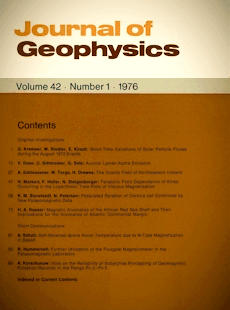Earth-flattening approximation for body waves derived from geometric ray theory - improvements, corrections and range of applicability
Article Sidebar

Vols. 1-18 (1924-1944), ISSN 0044-2801
Main Article Content
Abstract
A new derivation of the Earth-flattening approximation (EFA) for body waves from geometric ray theory is given which results in an improved version of the EFA. This version agrees with the EFA, derived by Chapman (1973) from wave theory. Moreover, it allows absolute, not only relative, body-wave amplitude calculations for given source time functions. The choice of the density transformation of the EFA is shown, by numerical calculations, to be uncritical for body-wave amplitudes in the period range up to 30 s. An error in an earlier derivation of the EFA (Muller, 1973a) is corrected. This error requires a new investigation of the range of applicability of the EFA, which is performed for the P-wave propagation through a homogeneous sphere. The results are similar to those of the earlier paper: long-period P waves with dominant periods up to about 20s can be treated practically exactly, as long as they do not pass closer than about 800 km to the Earth's center.
 ARK: https://n2t.net/ark:/88439/y046102
ARK: https://n2t.net/ark:/88439/y046102
Permalink: https://geophysicsjournal.com/article/89
Article Details
References
Fuchs, K., Muller, G. (1971) Computation of synthetic seismograms with the reflectivity method and comparison with observations. Geophys. J. R. A. S. 23:417 433
Gerver, M., Markushevich, V. (1966) Determination of a seismic wave velocity from the travel-time curve. Geophys. J. R. A. S. 11:165-173
Gilbert, F., Helmberger, D.V. (1972) Generalized ray theory for a layered sphere. Geophys. J. R. A. S. 27:57-80
Helmberger, D.V. (1973) Numerical seismograms of long period body waves from seventeen to forty degrees. Bull. Seism. Soc. Am. 63:633-646
Helmberger, D.V., Harkrider, D.G. (1972) Seismic source descriptions of underground explosions and a depth discriminate. Geophys. J. R. A. S. 31:45-66
Hill. D.P. 1972() An earth-flattening transformation for waves from a point-source. Bull. Seism. Soc. Am. 62:1195-1210
Muller, G. (1971) Approximate treatment of elastic body waves in media with spherical symmetry. Geophys. J. R. A. S. 23:435-449
Muller, G. (1973a) Theoretical body wave seismograms for media with spherical symmetry - discussion and comparison of approximate methods. J. Geophys. 39:229-246
Muller, G. (1973b) Amplitude studies of core phases. J. Geophys. Res. 78:3469-3490
Muller, G. (1976) Correction. Submitted to J. Geophys. Res.
MuIler, G., Mula, A.H., Gregersen, S. (1977) Amplitudes of long-period PcP and the core-mantle boundary. Phys. Earth Planet. Int. (In press)











